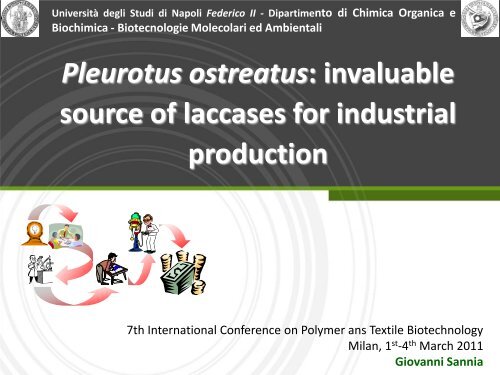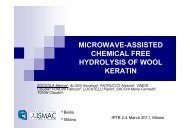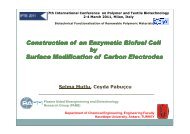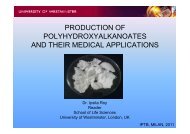Pleurotus ostreatus invaluable source of laccases for industrial production
A.101 - SANNIA Giovanni
A.101 - SANNIA Giovanni
- No tags were found...
You also want an ePaper? Increase the reach of your titles
YUMPU automatically turns print PDFs into web optimized ePapers that Google loves.
Università degli Studi di Napoli Federico II - Dipartimento di Chimica Organica e<br />
Biochimica - Biotecnologie Molecolari ed Ambientali<br />
<strong>Pleurotus</strong> <strong>ostreatus</strong>: <strong>invaluable</strong><br />
<strong>source</strong> <strong>of</strong> <strong>laccases</strong> <strong>for</strong> <strong>industrial</strong><br />
<strong>production</strong><br />
7th International Conference on Polymer ans Textile Biotechnology<br />
Milan, 1 st -4 th March 2011<br />
Giovanni Sannia
Laccases: general features<br />
Multi-copper-containing enzymes catalysing the oxidation <strong>of</strong> a wide spectrum <strong>of</strong><br />
aromatic compounds, primarily phenols and anilines, along with reducing<br />
molecular oxygen to water.<br />
The Cu1 is the primary electron acceptor site in laccase catalysed reaction. Four 1-<br />
electron oxidations <strong>of</strong> a reducing substrate occur at this site. The electron is then<br />
transferred, through the highly conserved His-Cys-His tripeptide, to the TNC,<br />
where O 2 is reduced to water.<br />
IPBT 2011, Milan Giovanni Sannia
Laccases: origin and distribution<br />
Laccase was first detected (1883) in the Japanese lac tree Toxicodendron verniciflua<br />
(<strong>for</strong>merly Rhus vernicifera).<br />
Later, it was found in certain other plants, in many insects, and in a variety <strong>of</strong> fungi.<br />
It is particularly widespread in ligninolytic basidiomycetes, and more than 125<br />
different basidiomycetous laccase genes have been described.<br />
The occurrence <strong>of</strong> laccase in prokaryotes<br />
species.<br />
seems to be restricted to certain<br />
IPBT 2011, Milan Giovanni Sannia
Laccases from white-rot fungi<br />
Glycoproteins (carbohydrate content between 10%-25%)<br />
<br />
<br />
<br />
<br />
<br />
<br />
Acidic pI<br />
Contain four copper atoms distributed into three redox sites:<br />
Type 1 (T1), Type 2 (T2) Type 3 (T3)<br />
Monomeric structure <strong>of</strong> 60-70 KDa<br />
Laccase structure is organized in three domains each with -barrel type<br />
architecture<br />
Many fungi produce several laccase isozymes differing with regard to<br />
optimum pH, substrate specificity, molecular weight, cellular localization,<br />
and quaternary structure. These enzymes are differentially expressed as<br />
function <strong>of</strong> the environmental growth conditions<br />
Laccase gene families have been found in different basidiomycetes,<br />
indicating that they may have evolved through duplication-divergence<br />
events.<br />
IPBT 2011, Milan Giovanni Sannia
Laccases: origin and distribution<br />
Due to their low substrate specifity <strong>laccases</strong> have widespread applications:<br />
• Effluent decolourisation and detoxification<br />
• Pulp bleaching;<br />
• Textile industries;<br />
• Biorefinery;<br />
• Conversion <strong>of</strong> chemical intermediates;<br />
• Removal <strong>of</strong> phenols from wines;<br />
• Fiber synthesis and grafting;<br />
• Biosensors;<br />
• Bi<strong>of</strong>uel cells;<br />
• Synthesis <strong>of</strong> drugs.<br />
IPBT 2011, Milan Giovanni Sannia
Laccases in Industry<br />
Industrial enzyme market<br />
is valued at $2 billion per<br />
annum with a potential<br />
annual growth rate <strong>of</strong> 3 to<br />
5%.<br />
Laccase stake in this market<br />
is about 4% thus making it a<br />
potential $800 million<br />
market cap.<br />
Source: BCC Research<br />
IPBT 2011, Milan Giovanni Sannia
A case study: P. <strong>ostreatus</strong> <strong>laccases</strong><br />
Task 1<br />
Structural functional<br />
characterization<br />
Laccases<br />
application<br />
Task 2<br />
Enhancing <strong>production</strong><br />
Task 3<br />
Improving enzyme<br />
per<strong>for</strong>mances<br />
IPBT 2011, Milan Giovanni Sannia
A case study: P. <strong>ostreatus</strong> <strong>laccases</strong><br />
Structural functional characterization<br />
Laccases<br />
application<br />
• Genome mining<br />
• Structure-function relationships analysis<br />
IPBT 2011, Milan Giovanni Sannia
P. <strong>ostreatus</strong> <strong>laccases</strong> gene families<br />
Investigation <strong>of</strong> the white-rot fungus P. <strong>ostreatus</strong> genome disclosed a complex MCO<br />
family composed <strong>of</strong> twelve members, ten <strong>of</strong> which correspond to <strong>laccases</strong> in sensu<br />
stricto.<br />
POX1<br />
POXC<br />
POX4<br />
LACC3<br />
LACC12<br />
LACC7<br />
POX3<br />
POXA1b<br />
LACC8<br />
POX5<br />
POXA3<br />
LACC5<br />
One putative fungal<br />
ferroxidase<br />
Seven out <strong>of</strong> twelve laccase genes<br />
and/or proteins isolated and<br />
characterized; all <strong>of</strong> them endowed<br />
with different peculiar properties<br />
One laccase<br />
pseudogene<br />
Genome mining<br />
IPBT 2011, Milan Giovanni Sannia
P. <strong>ostreatus</strong> <strong>laccases</strong><br />
POX1<br />
POXC<br />
POX4<br />
LACC3<br />
LACC12<br />
LACC7<br />
POX3<br />
POXA1b<br />
LACC8<br />
POX5<br />
POXA3<br />
LACC5<br />
A neutral blue laccase very stable at<br />
alkaline pH<br />
t 1/2 at pH 10: 100 days<br />
Giardina P., et al., Biochem. J. 1999<br />
Structure-function relationships analysis<br />
POXC is very effective in dye<br />
synthesis.<br />
Bioscreen<br />
POXC<br />
PS344<br />
CotA<br />
PO33<br />
PS7NI<br />
Remaining LAR1 ABu62produced<br />
0 500 200 1000 400 1500 600 2000 800 1000<br />
[ABu62] [LAR1] µM µM<br />
SOPHIED, European Project FP6 2004-2008<br />
An atypical heterodimeric<br />
laccase very effective in dyes<br />
decolourization.<br />
Reactive blue 19<br />
(Remazol Brilliant blue R -RBBR)<br />
Palmieri G., et al., Enz. Microb. Technol. 2005<br />
Palmieri G., et al., Biotechnol. Prog. 2005<br />
IPBT 2011, Milan Giovanni Sannia
A case study: P. <strong>ostreatus</strong> <strong>laccases</strong><br />
Enhancing <strong>production</strong><br />
Laccases<br />
application<br />
• Extracellular communication<br />
• Classical breeding<br />
• Cost reduction<br />
IPBT 2011, Milan Giovanni Sannia
Laccase activity U/ml<br />
Biomass log (g/l)<br />
Extracellular communication in P. <strong>ostreatus</strong><br />
€£≠∞<br />
?<br />
♂♫ךּשׁ<br />
…<br />
Metabolomic pr<strong>of</strong>ile <strong>of</strong> P. <strong>ostreatus</strong> cultures allowed to identify 12 putative<br />
signalling molecules.<br />
These molecules were used to condition submerged fungal cultures. Among<br />
these, 2-hydroxy-4-nitrobenzoic acid significantly increase laccase<br />
<strong>production</strong>. 40<br />
100<br />
induction<br />
35<br />
∆≥©♥<br />
30<br />
D<br />
10<br />
DAY<br />
25<br />
20<br />
15<br />
10<br />
5<br />
0<br />
C<br />
B<br />
0 1 2 3 4 5 6 7 8 9 10 11 12 13 14 15 16 17 18 19 20 21<br />
La<br />
c<br />
c<br />
as<br />
e<br />
a<br />
cti<br />
vit<br />
y<br />
U/<br />
ml<br />
1<br />
mass spectrometry<br />
Days giorni<br />
0 1 2 3 4 5 6 7 8 9 10 11 12 13 14 15 16 17 18 19 20 21<br />
A<br />
Secretomic analysis by<br />
0,1<br />
0,01<br />
Conditioned<br />
Control<br />
Extracellular communication<br />
Time course in PDY medium<br />
IPBT 2011,<br />
+ 150<br />
Milan<br />
µM CuSO4 Giovanni Sannia
Extracellular communication in P. <strong>ostreatus</strong><br />
Effect <strong>of</strong> 2-hydroxy-4-nitrobenzoic acid on protein pr<strong>of</strong>iles <strong>of</strong> P. <strong>ostreatus</strong> secretome.<br />
control<br />
2-hydroxy-4-nitro<br />
benzoic cid<br />
1<br />
8<br />
6<br />
5<br />
7<br />
2<br />
4<br />
3<br />
Besides <strong>laccases</strong>, <strong>production</strong><br />
<strong>of</strong> several <strong>industrial</strong>ly useful<br />
proteins was increased in<br />
conditioned medium.<br />
Differentially produced<br />
proteins detected after 9<br />
days <strong>of</strong> growth in<br />
conditioned medium<br />
Extracellular communication<br />
IPBT 2011, Milan Giovanni Sannia
Laccase <strong>production</strong>: troubles and solutions<br />
Strain selection<br />
Classical<br />
breeding<br />
Production cost<br />
Raw material<br />
Productivity<br />
Medium<br />
conditioning<br />
IPBT 2011, Milan Giovanni Sannia
Classical breeding by two P. <strong>ostreatus</strong> varieties<br />
Dikaryon 1<br />
Dikaryon 2<br />
Meiosis<br />
New monokaryons<br />
X<br />
Crossing <strong>of</strong> compatible new<br />
monokaryons<br />
New dikaryons<br />
P. <strong>ostreatus</strong> var.<br />
florida<br />
P. <strong>ostreatus</strong> var.<br />
<strong>ostreatus</strong><br />
…<br />
3D 9D 11D<br />
strain 1D 2D 3D 4D 5D 6D 7D 8D 9D 10D 11D 12D 13D 14D<br />
5A Nd Nd + Nd Nd Nd Nd Nd + Nd + Nd Nd Nd<br />
6A Nd Nd + Nd Nd Nd Nd Nd + Nd + Nd Nd Nd<br />
18A Nd Nd + Nd Nd Nd Nd Nd - Nd + Nd Nd Nd<br />
+ compatible (visible clamp connection); - incompatible (no clamp connection); N.d. not determed<br />
Three out <strong>of</strong> eight selected dikaryons proved to be good laccase producers<br />
IPBT 2011, Milan Giovanni Sannia
laccase activity (U/L) ;<br />
Laccase <strong>production</strong>s <strong>of</strong> the new dikaryotic strains AxD<br />
Basal medium: PDY+ CuSO 4 150mm<br />
50000<br />
40000<br />
30000<br />
20000<br />
10000<br />
0<br />
DAY<br />
0 1 2 3 4 5 6 7 8 9 10 11<br />
5AxD3 , 5AxD11 and 6AxD11 are the best<br />
producers<br />
IPBT 2011, Milan Giovanni Sannia
laccase activity (U/L) ;<br />
Laccase <strong>production</strong>s <strong>of</strong> the new dikaryotic strains AxD<br />
All the strains revealed to be differentially sensitive to the addition <strong>of</strong><br />
ferulic acid<br />
120000<br />
100000<br />
5AxD3 produces more<br />
80000<br />
than 100,000 U/L <strong>of</strong><br />
laccase activity in<br />
60000<br />
presence <strong>of</strong> ferulic<br />
acid (2mM)<br />
40000<br />
20000<br />
0<br />
0 1 2 3 4 5 6 7 8 9 10 11<br />
IPBT 2011, Milan Giovanni Sannia
Laccase <strong>production</strong>: troubles and solutions<br />
Strain selection<br />
Classical<br />
breeding<br />
Production cost<br />
Raw material<br />
Rapeseed cake<br />
Productivity<br />
Medium<br />
conditioning<br />
IPBT 2011, Milan Giovanni Sannia
Rapeseed cake as raw material <strong>for</strong> fungal<br />
fermentation<br />
Rapeseed (Brassica napus), is a bright yellow flowering member <strong>of</strong> the family<br />
Brassicaceae (mustard or cabbage family).<br />
Rapeseed is grown <strong>for</strong> the <strong>production</strong> <strong>of</strong> vegetable oil <strong>for</strong> human consumption, and<br />
biodiesel; leading producers include the European Union, Canada, the United<br />
States, Australia, China and India.<br />
The seeds <strong>of</strong> the rapeseed provides a quantity <strong>of</strong> oil ranging from 40 to 53% <strong>of</strong> dry<br />
matter.<br />
Processing <strong>of</strong> rapeseed <strong>for</strong> oil <strong>production</strong> provides rapeseed cake as a by-product.<br />
Agro-<strong>industrial</strong> residues are generally considered the best substrates <strong>for</strong> the bioprocesses,<br />
and use <strong>for</strong> fungal fermentation <strong>for</strong> the <strong>production</strong> <strong>of</strong> enzymes is no<br />
exception to that.<br />
IPBT 2011, Milan Giovanni Sannia
U/mL<br />
Costs and productivity: choosing <strong>of</strong> raw materials<br />
When grown in rapeseed cake + 150 mM Cu sulphate the new hybrids<br />
display different perfomances respect to parental strains<br />
40<br />
New dikaryons show high<br />
levels <strong>of</strong> <strong>production</strong> in the<br />
basal raw material<br />
Rapeseed cake is an useful<br />
low cost medium <strong>for</strong><br />
laccase <strong>production</strong><br />
0<br />
3<br />
days<br />
4 5 6 7 9<br />
11 13 17 18<br />
ATCC 5AxD3 6AxD11<br />
30<br />
20<br />
10<br />
0<br />
IPBT 2011, Milan Giovanni Sannia
Laccase <strong>production</strong>: troubles and solutions<br />
Strain selection<br />
Classical<br />
breeding<br />
Production cost<br />
Raw material<br />
Rapeseed cake<br />
Productivity<br />
Medium<br />
conditioning<br />
Lignosulphonates,<br />
aromatics, N- and<br />
C-<strong>source</strong>s<br />
IPBT 2011, Milan Giovanni Sannia
Costs and productivity: choose <strong>of</strong> inducers and additional<br />
nutrient <strong>source</strong>s<br />
U/ml<br />
The effect <strong>of</strong> different inducers, N- and C- <strong>source</strong>s on laccase yields, was tested<br />
Inducers Concentration<br />
2,5-xilidine 1-2 mM<br />
Gallic acid 1-2 mM<br />
Ferulic acid 1-2 mM<br />
Sinapinic acid 1-2 mM<br />
p-cumaric acid 1-2 mM<br />
Caffeic acid 1-2 mM<br />
Lignosulphonate 15-30 g/L<br />
C- Sources Concentration<br />
Wheat-straw 15-30 g/L<br />
Starch<br />
15-30 g/L<br />
N-<strong>source</strong>s Concentration<br />
Yeast extract 5-15-30g/L<br />
100<br />
80<br />
60<br />
40<br />
20<br />
0<br />
days<br />
4 5 6 7 9 10<br />
IPBT 2011, Milan Giovanni Sannia
Costs and productivity: choose <strong>of</strong> inducers and additional<br />
nutrient <strong>source</strong>s<br />
The effect <strong>of</strong> different inducers, N- and C- <strong>source</strong>s on laccase yields, was tested<br />
PDY + 150 µM CuSO 4<br />
+ 2mM Ferulic<br />
Acid<br />
€/L Umax/L €/U<br />
~4.5 ~150,000<br />
Rapeseed cake + 150 µM CuSO 4<br />
0.00615 35,000<br />
3.00<br />
E-05<br />
1.76<br />
E-07<br />
Many <strong>of</strong> them resulted in an<br />
increased laccase <strong>production</strong><br />
respect to basal conditions<br />
Rapeseed cake + 150 µM CuSO 4<br />
+<br />
2mM Ferulic acid<br />
Rapeseed cake + 150 µM CuSO 4<br />
+<br />
2mM Gallic acid<br />
0.18075 50,000<br />
0.08315 68,000<br />
3.62<br />
E-06<br />
1.22<br />
E-06<br />
How much<br />
does it cost?<br />
Rapeseed cake + 150 µM CuSO 4<br />
+<br />
1mM 2-5,xilidine<br />
0.02615 58,000<br />
4.51<br />
E-07<br />
Rapeseed cake + 150 µM CuSO 4<br />
+<br />
15g/L Starch<br />
Rapeseed cake + 150 µM CuSO 4<br />
+<br />
30g/L lignosulphonates<br />
Rapeseed cake + 150 µM CuSO 4<br />
+<br />
yeast extract<br />
1.33615 60,000<br />
0.05265 100,000<br />
0.16115 65,000<br />
2.23<br />
E-05<br />
5.27<br />
E-07<br />
2.48<br />
E-06<br />
Rapeseed cake 0,015€/kg<br />
CuSO4 ~100€/kg<br />
lignosulphonates 1,55 €/kg<br />
Starch 89 €/kg<br />
2-5 xilidine 170 €/kg<br />
Gallic acid 225 €/kg<br />
Ferulic acid 450 €/kg<br />
IPBT 2011, Milan Giovanni Sannia
Response surface methodology: factors and boundary<br />
conditions<br />
Rapeseed cake<br />
Placeholder Levels: 1X text – 0.5X<br />
Yeast extract<br />
Levels: 0 - 5g/L<br />
CuSO 4<br />
Levels: 150 – 450 µM<br />
Lignosulphonates<br />
Level: 20 – 60g/L<br />
Analysis was per<strong>for</strong>med with Minitab v.16 ®<br />
IPBT 2011, Milan Giovanni Sannia
Response surface methodology: experiments setting<br />
and computing matrix<br />
Once factors and leveles were<br />
defined, 27 experiments were<br />
planned<br />
Results were added to the<br />
computing matrix<br />
Maximum value indicated by +<br />
Minimum value indicated by -<br />
Average value indicated by 0<br />
Quadratic equation model was<br />
constructed<br />
Evaluation <strong>of</strong> media costs was<br />
per<strong>for</strong>med and added to the<br />
matrix<br />
IPBT 2011, Milan Giovanni Sannia
Responce Surface Methodology: optimization<br />
processing<br />
Maximization <strong>of</strong> laccase <strong>production</strong><br />
and minimiziation <strong>of</strong> culture<br />
medium cost<br />
Costs<br />
Productivity<br />
Company<br />
Commercial market cost<br />
Predicted Responses:<br />
U/l = 190,000<br />
€/l = 0.16<br />
€/U = 8.62E-07<br />
Novozym 51003 1,05 E-04<br />
Novo Denlite II 1,99 E-04<br />
P. <strong>ostreatus</strong> 8.00 E-04<br />
Sigma 3,30 E-03<br />
Bioscreen<br />
(0xizym)<br />
1,12 E-03<br />
Wetlands 1,20 E-03<br />
Jena<br />
Biosciences<br />
6,00 E-02<br />
IPBT 2011, Milan Giovanni Sannia
Scaling up: the final countdown!<br />
Classical<br />
Strain selection<br />
breeding<br />
Production cost<br />
Responce surface<br />
methodology<br />
Rapeseed<br />
Raw cake material<br />
Productivity<br />
Lignosulphonates<br />
Medium<br />
and N-<strong>source</strong>s<br />
conditioning<br />
Pilot-scale<br />
IPBT 2011, Milan Giovanni Sannia
A case study: P. <strong>ostreatus</strong> <strong>laccases</strong><br />
Improving enzyme per<strong>for</strong>mances<br />
Laccases<br />
application<br />
• Recombinant expression in suitable hosts<br />
• Functional evolution<br />
IPBT 2011, Milan Giovanni Sannia
P. <strong>ostreatus</strong> laccase functional evolution<br />
Mutant Generation activity<br />
pH stability<br />
pH3 pH5 pH7 pH10<br />
Mutant Generation activity<br />
T<br />
stability<br />
1M9B I 1.5x Χ Χ Χ Χ Χ<br />
pH stability<br />
pH3 pH5 pH7 pH10<br />
T stability<br />
1L2B II 2.5x Χ √ Χ √ √<br />
1M10B II 2.5x Χ √ √ √ √<br />
3M7C II 2.5x Χ √ √ √ √<br />
Three generation <strong>of</strong> libraries<br />
(3,300 variants) have been<br />
screened using different<br />
criteria, and seven variants<br />
endowed with improved<br />
features have been selected<br />
Mutant Generation activity<br />
pH stability<br />
pH3 pH5 pH7 pH10<br />
T<br />
stability<br />
R4 R4 2.5x Χ √ √ √ √<br />
Mutant Generation activity<br />
pH stability<br />
pH3 pH5 pH7 pH10<br />
T<br />
stability<br />
1H6C III 4.5x Χ √ √ √ √<br />
4M10G III 4.5x Χ √ √ √ √<br />
Functional evolution<br />
Festa G., et al., Proteins 2008<br />
Miele A., et al., Enz. Microb. Technol. 2009<br />
Miele A., et al., Mol Biotechnol. 2010<br />
IPBT 2011, Milan Giovanni Sannia
P. <strong>ostreatus</strong> laccase functional evolution<br />
Specific<br />
Activity<br />
(U/mg)<br />
Stability pH<br />
t ½ (days)<br />
Stability T<br />
t ½ (h)<br />
pH3 pH5 pH7 pH10 pH7, 60°C<br />
Wild type 155 ± 1 5.8 10.3 11.3 30.0 4.5<br />
1H6C 700 ± 1 3 35 39 63 7.2<br />
The best selected mutant, 1H6C, and the wild-type enzyme, POXA1b, were<br />
heterologously expressed in Aspergillus niger<br />
Aspergillus niger<br />
POXA1b<br />
1H6C<br />
Extracellular Activity 38,500 U L -1 55,500 U L -1<br />
IPBT 2011, Milan Giovanni Sannia
Laccases application<br />
Production and tailoiring <strong>of</strong><br />
<strong>laccases</strong> is in progress<br />
1<br />
2<br />
3<br />
4<br />
Protein characterization<br />
is being completed<br />
Industrial applications……..Coming soon!<br />
IPBT 2011, Milan Giovanni Sannia
People<br />
Giovanni Sannia<br />
Cinzia Pezzella<br />
Alessandra Piscitelli<br />
Lucia Guarino<br />
Vincenzo Lettera<br />
Paola Giardina<br />
Claudia Del Vecchio<br />
Laura Sorrentino<br />
Vincenza Faraco<br />
Gemma Macellaro<br />
IPBT 2011, Milan Giovanni Sannia
Collaboration<br />
Lucía Ramírez & Antonio G. Pisabarro<br />
Genetics and Microbiology Research Group- Public University <strong>of</strong> Navarre- Spain<br />
DOE Joint Genome Institute<br />
Riccardo Basosi & Rebecca Pogni<br />
Dipartimento di Chimica- Università degli studi di Siena- Italia<br />
Sophie Vanhulle & Alexandra Bazes<br />
Microbiology Unit - Université Catholique de Louvain- Belgium<br />
Thierry Tron<br />
CNRS, Faculté des Sciences et Techniques. Saint Jérôme Marseille- France<br />
Tajalli Keshavarz<br />
Biotechnology Department - School <strong>of</strong> Biosciences- University <strong>of</strong> Westminster- UK<br />
IPBT 2011, Milan Giovanni Sannia







